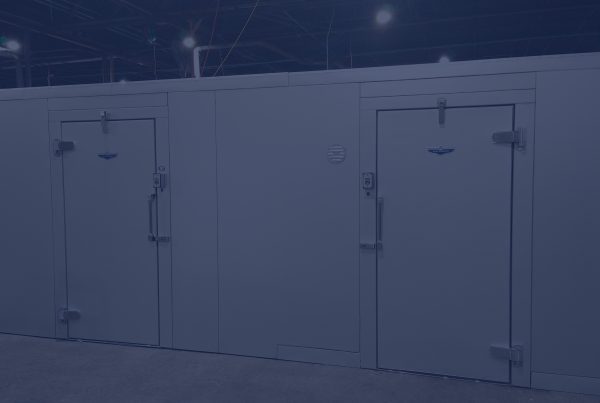The Department of Energy (DOE) has written their interpretation on compliant refrigeration vs. non-compliant refrigeration on walk-in coolers and freezers. Below, DOE explains that any component added to a previously installed walk-in cooler or freezer and manufactured after January 1, 2009, must meet EISA guidelines. This is a draft document and comments and suggestions must be submitted to the Department of Energy prior to February 20, 2012.
The Interpretation from the Department of Energy (DOE)
This is a draft document and does not represent a definitive view of the agency on the questions addressed.
This and other guidance documents are accessible on the U.S. Department of Energy, Energy Efficiency & Renewable Energy web site at: http://www1.eere.energy.gov/guidance/default.aspx?pid=2&spid=1.
Guidance Type: Conservation Standards, Enforcement
Category: Commercial Equipment
Product: Walk-in Cooler and Walk-in Freezers
Guidance Version: DRAFT
Issued: January 20, 2012
Comment Period Closes: February 20, 2012Q: What are the relevant dates for compliance with the prescriptive requirements for walk-in coolers and walk-in freezers? For example: If a newly manufactured component of a walk-in cooler or walk-in freezer is installed in a walk-in box manufactured prior to January 1, 2009, does it have to comply with the prescriptive requirements of 10 C.F.R. § 431.306?
A: The following is a draft U.S. Department of Energy (DOE) guidance document regarding commercial walk-in coolers and walk-in freezers. This draft guidance document represents the Department’s interpretation of its existing regulations and is exempt from the notice and comment requirements of the Administrative Procedure Act. See 5 U.S.C. § 553(b)(A). Therefore, the Department is accepting comments and suggestions from the public until February 20, 2012. Comments and suggestions should be provided in WordPerfect, Microsoft Word, PDF, or text file format by sending an email to WICFEISA2007Guidance-2012-0001{at}ee.doe.gov. Please also include the docket number EERE-2012-BT-STD0001.
At the end of the comment period, this draft guidance document may be adopted, revised or withdrawn.
Earlier this year, DOE issued two rules that detailed a general approach with respect to the regulation of walk-in coolers and freezers (“WICFs” or “walk-ins”) –the WICF test procedure final rule (76 Fed. Reg. 21580 (April 15, 2011)) and the certification, compliance, and enforcement (CCE) final rule (76 Fed. Reg. 12422 (March 7, 2011)). Because the statutory framework enacted by Congress established a series of component-based standards, DOE opted to follow this approach in regulating this equipment by establishing a test procedure that accounts for these component-specific standards. This approach effectively results in enforcement at the component level and requires component manufacturers to certify that the components they produce meet the applicable standard or standards. The CCE rulemaking further clarified that assemblers of walk-in systems are required to use only components that comply with the Federal standards. 76 FR 12422, 12444.
In response to these rules, DOE has received a number of questions regarding how to apply the component-based approach when deciding which replacement components to install into WICF applications. Specifically, under what circumstances must WICF replacement components meet the applicable Federal standards? This guidance document addresses that question as it pertains solely to those requirements that have already been prescribed in EPCA as a result of amendments added by the Energy Independence and Security Act of 2007 (Pub. L. No. 110-140 (Dec. 19, 2007)) (EISA). These requirements, which are currently in place and became effective as of January 1, 2009, are also found at 10 CFR 431.306. DOE may amend this guidance in the future as needed.
The guidelines presented below, which are consistent with the component-level approach established by Congress, include examples to illustrate their application.Guideline 1: All WICF components covered under EISA and manufactured on or after January 1, 2009, that are used in WICF applications must comply with the relevant EISA requirements. This includes WICF components that are assembled to make a newly constructed WICF and a WICF component that goes into an existing, previously installed WICF to replace a component.
Example 1: A display door manufactured after January 1, 2009, and used in a walk-in cooler must comply with the relevant EISA requirements for a walk-in cooler display door no matter whether the display door is being installed in a new WICF or is a replacement for a display door in an existing WICF. (If the same or similar display door is used in an application other than a WICF, it does not have to meet the EISA requirements for WICF display doors.)
Example 2: A WICF evaporator, manufactured prior to January 1, 2009, requires a replacement fan motor. If the replacement fan motor was manufactured after January 1, 2009 and is going to be used as a replacement for an existing WICF, it must be compliant with the WICF standard. Thus, the motor must be an ECM motor or a 3-phase motor.Guideline 2: WICF components covered by EISA and manufactured prior to January 1, 2009, that are installed in WICFs manufactured prior to January 1, 2009, do not have to meet the relevant EISA requirements.
Example: A WICF manufactured prior to January 1, 2009, needs a replacement door. The door may be replaced from existing inventory consisting of replacement doors manufactured prior to January 1, 2009, and that door does not have to meet the EISA requirements for doors.DOE believes this approach is permissible under the legal framework established by EISA and will not cause undue burden for the following reasons. First, DOE expects there to be a sufficient supply of WICF components to meet the demand for replacement components for WICFs manufactured after January 1, 2009. Component manufacturers are already producing compliant components as required under EISA, and supplying owners of pre-2009 WICFs with components as needed should not present any problems given the relatively small demand.
DOE also believes customers will not be “stranded” – that is, unable to find replacement components for WICFs manufactured before January 1, 2009 – because existing products are available to meet the demand. For example, many motor manufacturers offer ECM motors as drop-in replacements for shaded pole and PSC fan motors that were installed in pre-2009 WICFs. For envelope components, which may be custom-made, DOE expects that in the majority of cases, manufacturers would be capable of supplying EISA-compliant components to replace non-EISA-compliant components that were manufactured before January 1, 2009. For example, if a cooler non-display door or panel made of 3 ½ inches of expanded polystyrene foam fails, it can be replaced with a component made of 3 ½ inches of extruded polystyrene or polyurethane foam, which would meet the EISA R-value requirement. If a freezer display door with 2 panes of glass fails, it can be replaced with a 3-pane door. In a case where the component must be replaced with a component of different dimensions to meet the standard – for instance, if a 3-inch freezer panel would have to be replaced with a 4-inch panel – manufacturers and customers have several options. If the panels can be connected using the panel locking system, the difference in thickness can be made up with gasketing. The panel can also be replaced with a 3-inch panel from inventory manufactured before January 1, 2009. Another option is to replace the panel with a used panel; used components are not covered under the EISA requirements, which only apply to new products.
Finally, DOE believes manufacturers will not be left with a significant amount of inventory they cannot sell. Any components manufactured prior to January 1, 2009, can be used as replacement components in WICFs manufactured before January 1, 2009. DOE realizes that in the absence of comprehensive guidance, some manufacturers may have continued to produce replacement components for pre-2009 walk-ins that did not meet the EISA standards even after the January 1, 2009, compliance date. To address this concern, the guidelines presented in this document will not be applied retroactively to components made prior to the issuance of this guidance but on or after January 1, 2009. As a result, if a manufacturer in 2010 produced a panel that did not meet the required R-value as a replacement for a panel in a WICF manufactured prior to January 1, 2009, the manufacturer would not be penalized for producing a noncompliant component. DOE does not believe that any additional lead time is warranted.
DOE believes the approach outlined in these guidelines will enable manufacturers to satisfy the EISA requirements without subjecting them or their customers to an undue burden. The approach ensures that all new equipment manufactured since January 1, 2009 – both complete WICFs and components thereof – comply with the EISA requirements while permitting components manufactured before January 1, 2009, or used components, to be used as replacement components in WICFs manufactured before January 1, 2009. Finally, this guidance is consistent with the component-level approach enacted by Congress through EISA and requires newly manufactured components to comply with the applicable standards regardless of whether they are used in a new installation or as replacement components for a previous installation.
The original DOE PDF can be found here.



